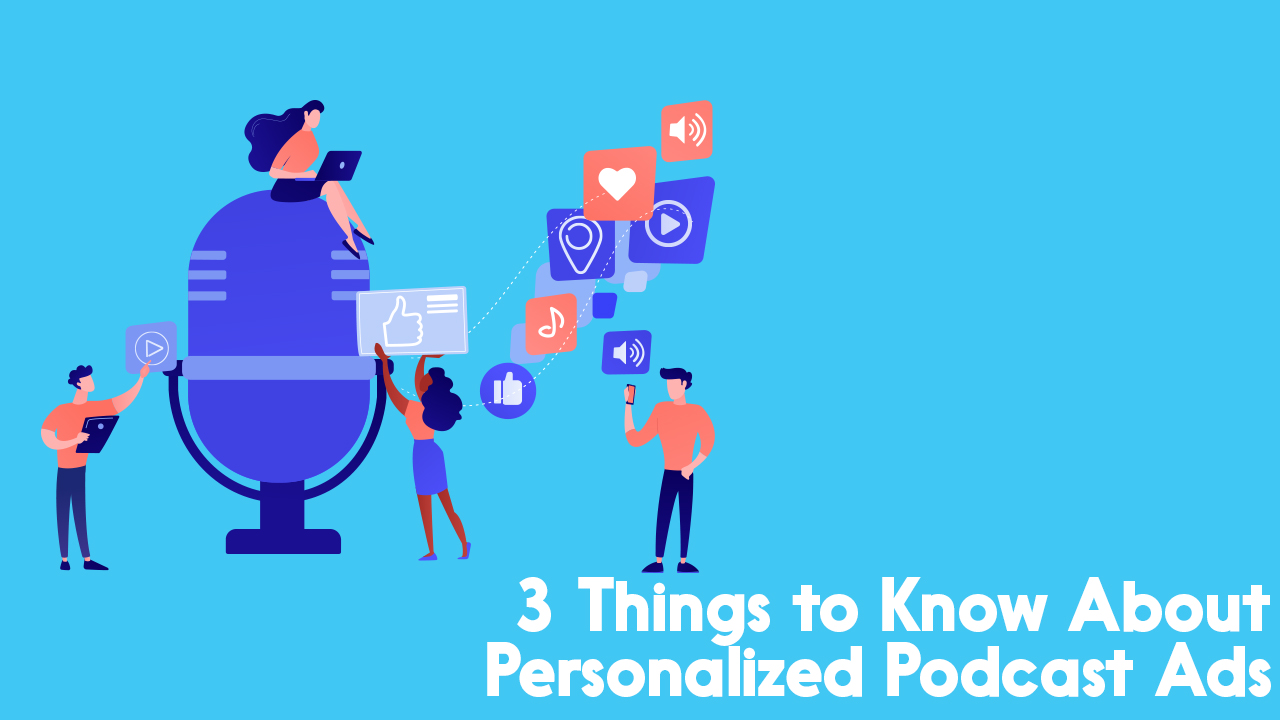3 Things to Know About Personalized Podcast Ads & Their Impact

The golden age of television is gone. We’re now in the era of digital media consumption, where OTT (Over The Top) platforms, YouTube, and social media content are on the rise. Amid all this video hype, podcasting has silently emerged as one of the most consumed content types. 57% of people in the US have listened to a podcast at least once. This growing viewership has given rise to personalized podcast advertising opportunities. Let’s look at all you need to know about personalized podcast ads.

What Is Podcast Ad Personalization?
Podcast ad personalization refers to the act of using listeners’ insights and information to increase the relevancy of ads shown to them.
Podcast advertisements come in three placements variants:
- Pre-Roll Ads: Ads that appear at the beginning (or before) of the podcast
- Mid-Roll Ads: Ads that appear during the podcasts; multiple mid-roll ads may be there in a podcast depending on the podcast length
- Post-Roll Ads: Ads that appear after the podcast is over
Of the three ad placements, mid-roll ads get more engagement as they appear within the podcast content. For the same reason, they cost more than other types of ads.
Podcast ads are of two types. The first type is baked-in sponsorships, where the host reads an advertisement pitch either during the podcast recording or records it separately and then adds it to the podcast content. As a result, the ad will be a part of the single audio file that the listener can stream or download. Baked-in ads make for around 66% of total podcast advertising revenue and are 3.5 times more efficient than the second type of podcast ads – dynamically inserted ads.
In dynamically inserted ads, an ad network places the ads based on the specific listener. The hosts don’t record these ads. They’re recorded and produced elsewhere and then placed in the podcast. If you tune into the Joe Rogan Experience on YouTube, the ads you’ll see in the beginning are dynamically inserted.
A major reason why dynamic ads get less engagement is the lack of personalization. Close to 80% of consumers say they’ll only engage with an offer if it’s been personalized based on their previous interactions with the brand. Hence, ad networks are focusing on ad personalization to enhance engagement and participation.
The importance of ad personalization goes beyond podcast advertisements. Regardless of the channel you choose – search engines, social media, YouTube, etc. – personalizing your advertising and marketing efforts can go a long way in driving engagement and user participation.
Here’s why advertisers should prioritize ad personalization.
- Create better, curated content
- Effectively target specific audiences
- Give a face to your business
- Foster meaningful customer relationships
- Make relevant product recommendations
- Drive sales and conversions
Three Things to Know About Podcast Ad Personalization
While podcast ad personalization opens doors for various advertising opportunities, there are a few things to keep in mind. These include:
Industry Standards, Viewership, and Pricing
Pre-roll and post-roll ads are 15 seconds long, whereas mid-roll ads are 60 seconds long. While mid-roll ads can be placed at any point in the podcast, they’re usually placed when the listener has listened to around 40-70% of the podcast.
Here are the ballpark advertising rates charged by podcast hosts:
- $18 per 1,000 listens for pre-roll and post-roll ads
- $25 per 1,000 listens for mid-roll ads.
Lastly, podcast viewership is growing worldwide. Podcast listeners have been increasing, as 56% of 12-34 year-olds listen to podcasts on a monthly basis. This has opened the gates for advertising opportunities for brands across all industries. Monica Adarsh, senior marketing manager at Beaconstac, says, “Personalized podcast ads have helped us drive substantial business growth. We have witnessed more than 70% surge in free trial sign-ups for our product QR code generator in two months.”
When startups and SMBs formulate a marketing strategy, they often focus all their attention on creating visually appealing images and video advertisements for search engines and social media. Not many brands realize that if implemented correctly, podcast advertising can generate a higher return on investment (ROI).
A majority of internet users use adblocker software to block annoying display ads. If you’re investing in display advertising, the chances are that your ads are being automatically blocked. Contrarily, as many as 78% of podcast listeners approve of podcast ads. This results in better engagement and improved ROI. Some other reasons why you should leverage personalized podcast ads are:
- Podcasters are one of the most engaged and loyal audiences of a medium.
- Podcasts are easy to consume. Consumers can listen to them while exercising, commuting, or doing laundry.
- Podcast advertising isn’t limited to specific channels. You can reach your potential customers across all channels.
- Podcast listeners are selective, which enables you to be more relevant.
- Podcast listeners typically belong to a higher income bracket with higher education levels.
- If you opt for baked-in ads, your endorsement will remain in the podcast forever, resulting in a permanent endorsement.

Ads and Listeners’ Privacy: Do Hosts Need to be Worried?
Since personalized podcast ads are booming, a common question among hosts is that if they can be a threat to the listeners’ privacy. While the answer depends on the privacy risks one is referring to, for the most part, it’s not a threat. The podcast hosting company gets access to only the IP address that sent the request. No additional cookies or tracking mechanisms exist in podcasting.
Since IP addresses are dynamically assigned, the actionable data available for advertising and targeting is limited. Hence, there’s no identifiable privacy risk associated with personalized podcast ads. In fact, no digital advertisement carries a privacy risk as to the advertisers, and ad networks don’t have access to the personal or sensitive information of the users.
However, some privacy issues may arise depending on the platform used. Podcasts are nothing but an RSS feed that listeners can stream from any server without sharing their personal information. However, platforms like Spotify may combine user behavior with app behavior to show targeted advertisements, which might pose a privacy risk. Since podcast listeners have no control over the way podcast platforms collect and store their data, it could be a worrying threat.
The speculated privacy issues with ad personalization aren’t limited to podcast ads. The International Journal of Advertising published a study in 2017 which stated that the majority of customers were worried about the privacy threats posed by personalized ads. Consumers are cautious about how advertisers attain their personal information and how they use it. The study further showed that the perception of risk among consumers was stronger than the benefits associated with personalized ads.
However, studies are contradictory. Research from Accenture shows that 48% of consumers say that they are more likely to purchase from personalized recommendations. To find success with personalized advertising, companies need to stay transparent about how they collect customer information, what data they collect, and how they use it.
The Future of Personalized Podcast Ads is Bright, But
The growing podcast viewership indicates that the future of podcast advertising is bright. But the potential safety concerns can impact the way ads are personalized.
While personalized podcast advertising is raising some red flags, fighting ad tracking will result in nothing but more irrelevant ads. If there’s no data tracking and personalization, ad rates will decrease. To compensate for the losses, ad publishers will need to show more ads. This will result in a multitude of irrelevant ads that’ll deteriorate the consumer experience even further.
Ad personalization won’t stop, but it can certainly change. There could be new ways to personalize ads without risking the listeners’ privacy. An effective way to do so is by collecting registration information. Instead of anonymously collecting data, podcast hosting platforms can work with the show service to show personalized ads based on the information the service has about the user. The podcast industry has already taken steps in this direction. But this technique limits the targeting capabilities, which has curbed the enthusiasm of advertisers.
How Personalized Podcast Ads Impact Audience Experience?
The way advertisers approach advertising has changed significantly. Back in the day, podcast advertising was all about quantity. The more ads mid-rolls you put inside a podcast, the more engagement it’ll receive. Thanks to the advent of data collection and analysis, the approach has shifted from quantity to quality and relevance, which boils down to personalization.
Final Thoughts
As podcast viewership continues to grow, podcast hosts can explore various brand collaboration opportunities. On the other hand, advertisers can leverage the increasing viewership to reach a wider audience and increase brand awareness. While podcast advertising will offer numerous opportunities in the future, there are some privacy challenges that podcast hosts will need to address.
